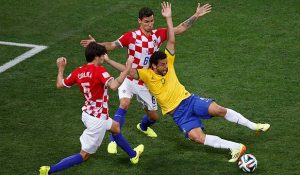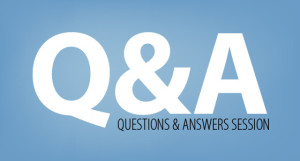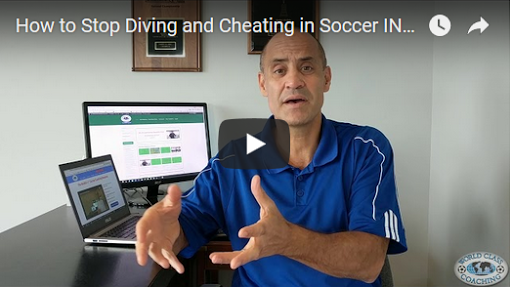Podcast: Play in new window | Download
Subscribe: Apple Podcasts | RSS
 My teams are making the transition to indoor Futsal training this week. Some of them still have an outdoor tournament this weekend but our club always moving inside on the first of November.
My teams are making the transition to indoor Futsal training this week. Some of them still have an outdoor tournament this weekend but our club always moving inside on the first of November.
I enjoy the change of pace and the focus on different skills and tactics. Some coaches focus on training Futsal in isolation but I look at how the game as an opportunity to better prepare my teams and players for a return to the outdoor game in the spring.
This winter I’m focusing on a couple of key areas that I think will really benefit my players in the future as well as help them understand the unique elements of Futsal.
 This week’s question comes from Luis. He asks about lack of focus during training
This week’s question comes from Luis. He asks about lack of focus during training
Luis says,
“I had a question. I coach a Girls 2005 team so all the players are 12 or turning 12 soon. Seven of the girls played with me last year and most if not all have played with one another at some point or another over the last four-plus years, so everyone is familiar with one another. This is good as the team has bonded well together, but the problem is that it has bonded too well.
The girls often talk and giggle and mess around and lose focus. I try to combat this by keeping my practices fast paced with things they like to do, but that doesn’t seem to be working. Any break in our sessions, no matter how small, and they lose focus. This is a problem with about 9-10 of our 14 players.”
Luis’ question was actually about how to handle this with the players but I think there’s something else involved here that I’d like to focus on. How long should someone coach one team?
There are a lot of different opinions and circumstances to consider. I outline my perspective in the episode.
In This Episode
What’s one of the things that non-soccer fans always point to as the reason they don’t like soccer – Diving. What’s one of the things that non-soccer fans always point to as the reason they don’t like soccer – Diving. What causes more unfair results than anything else in our game – Diving.
Today I focus on what we CAN and SHOULD do to remove diving from our game.
Here’s an opinion video from WORLD CLASS COACHING President, Mike Saif, about:
How to Stop Diving and Cheating in Soccer INSTANTLY.
Ranking and Reviews
I’d like to ask you a favor, we have 96 rankings and reviews on our Apple Podcast profile. I’d love to get that above 100 this week. If you’ve ever found any of the information I’ve shared over the last, nearly three years, helpful or interesting please take two minutes and give us a quick ranking and review through your iTunes account. It will help push us over 100 and keep us near the top of the rankings for soccer podcast.
Future Episodes
Next week I’m going to speak with Ola Larsson about his SuperCoach app and unique ideas for constructing technical exercises.


I make an effort in every competition I participate in to uphold the highest standard of good sportsmanship and to compete without violating the rules (by definition “fouls”). In this “beautiful game” by the rules of the game there should be no tripping, pushing, shirt pulling, obstruction, malicious contact etc. etc.
However I know that passion and 100% effort often leads players down paths of decision making where they go over the line and foul. Often with awareness of a true intent. The consequence of a foul in the box that is clear to the referee is game changing. So this provides strong motivation that any suspicious contact to be made clear to the referee and unfortunately events occur where there could have been contact but the referee has a poor point of view.
In the case of no foul being made to look like a foul is easy for us all to agree should have consequences when it is unambiguously seen. But as Tom suggested the real complexity is with all of the other events. We react to over acting not necessarily because there was or was not a foul but because the behavioral response is out of sync with the event. In my mind there are two directions for the discussion.
One train of argument is to argue about enforcement. It is easy when and if there is irrefutable video evidence of no contact. When VAR becomes a common part of the game, post-game analysis can easily be included and provide substantial fines. But the camera angles are just another referee’s point of view and players will continue to attempt to gain the advantage especially in the box. The implementation of players wearing sensors could theoretically add additional information. But often only a slight grazing contact is enough to throw a player off balance and be unable to strike the ball true. The sensors could remove a degree of ambiguity as to whether there was contact and how “hard” the contact was, but not entirely whether it warrants being officially called. Remember all of the fouls by the rule of the game by definition are fouls and theoretically should be called. But many are not, as Tom discussed it and is officially called “considerations”. The fouls are either not seen or seen but deemed insufficient to warrant a “call”. Like grabbing on shirts etc. In most cases across the field calls are only a stoppage of play. Theoretically the fouls by any one player could be unambiguously added up. We could have game monitors in communication with referees keeping track. This could provide fouling statistics for every individual player and there could be a consequence. There could be a great deal more effort on eliminating fouls and “dishonest” efforts of fouling and acting like one is fouled. But many would argue, as would I, that enforcement like this could be very expensive and could seriously inhibit play and how players play the game. There are many ways that we can imagine our investing too much effort to “control” players and “control” the game that would be detrimental to the game. In the professional game we should always help motivate governing bodies, owners and professional players to understand that their economic benefit comes with an obligation to provide role models of good sportsmanship. But it is difficult to create a culture that enforces these things that focuses on punitive losses of revenue. Our community has to work on communicating how important it is that these people understand the the economic benefits comes with a clear responsibility. The only way to do that it to make sure we communicate our displeasure when bad sportmanship is unambiguously revealed.
The other argument is about players responses to fouls. It is an ambiguity that can be understood by using a hypothetical situation where a professional player has a well planted foot, the turf is stable, the player has the ability to withstand the pain from an unintentional hacking contact; they ignore the foul, strike the ball at the goal, stand watching the keeper parry away the ball and then run after the ball. The referee could be in a good or bad position to see the contact. The reality is that it is a foul and theoretically should be “by rule” called every time. Now add into the equation the white line drawn on the field at a specific (but arbitrary) distance from the goal. Add then the optional behavioral responses from the player that range from jogging off the pain; stopping and bending over to hold and rub his ankle; dropping to the ground and rubbing his ankle; or ultimately dropping and writhing on the ground allowing the pain consume him. All of these are possible decisions and responses by the well conditioned profesional athlete. What should he do? What will he do? Personally I have had many kicks to my ankles and feet that I find can sometimes be ignored and I can continue to play, jogging them off. Sometimes they are seen by the referee, sometimes the referee allows play to continue and sometimes but not always he returns to the event and punishes for the infraction. But the line of the box changes the nature of the punishment from something that might be helpful to one that is always potentially game changing. It changes the impact of the call, it changes the meaning of the pain felt by the player.
The truth is as long as the game has the rule about fouls in the penalty box that lead to a penalty kick, incidents in the box will be difficult to judge as to what is appropriate both in terms of enforcement and in terms of behavioral response of the player fouled. The referee will always have only a split second to see it and make a decision and then perhaps with VAR to take a few moments to reflect on the decision. The player in one instance can easily ignore the pain and in another cannot. We should all do our best to continue to reward good sportsmanship and to punish and discourage those who make decisions that violate fair play. And at the professional level, with so much money involved we need to demand that all the technology that can be used, be used. But I do not agree that it is ruining the game. Bending the rules of any game is the natural consequence of playing a game by rules. This is best exemplified by watching young players playing a conditional game set up by a coach to train a particular aspect of the game. Those players will quickly discover and emphasize in their play any behavior that does not violate the rules but provides them with an advantage, even if that behavior has nothing to do with the game or what the coach had intended. Counting cards in gambling, different types clubs in golf, sticky gloves in football, bat tar in baseball. This is how we play and define games. We all agree that egregious cheating should not be tolerated and should be punished. I think in most unambiguous cases it is and this is how we maintain the integrity of every game we enjoy playing and watching.
Thanks for your thoughtful comments.